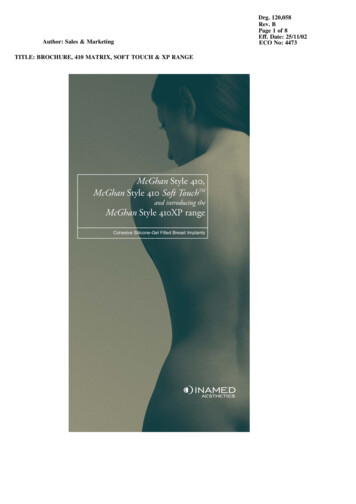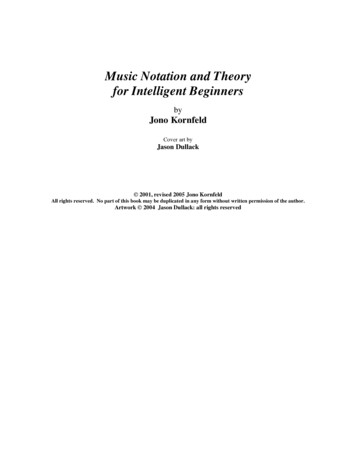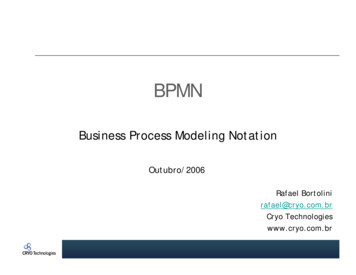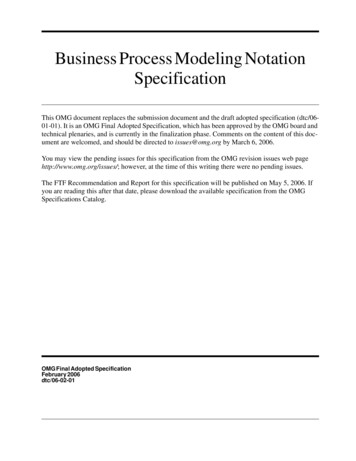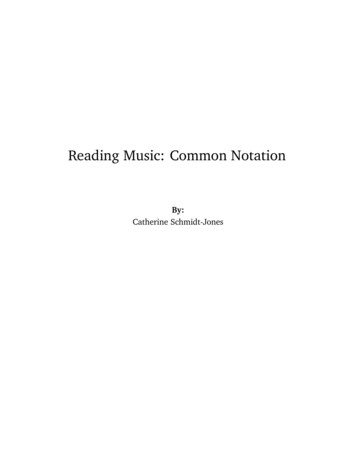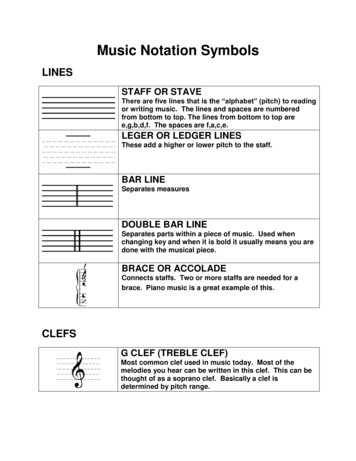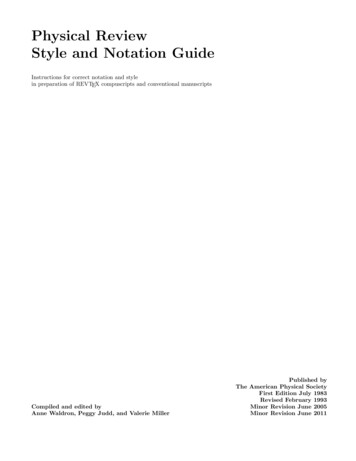
Transcription
Physical ReviewStyle and Notation GuideInstructions for correct notation and stylein preparation of REVTEX compuscripts and conventional manuscriptsCompiled and edited byAnne Waldron, Peggy Judd, and Valerie MillerPublished byThe American Physical SocietyFirst Edition July 1983Revised February 1993Minor Revision June 2005Minor Revision June 2011
Copyright 1993, by The American Physical SocietyPermission is granted to quote from this journal with the customary acknowledgment of the source. To reprint a figure, tableor other excerpt requires, in addition, the consent of one of the original authors and notification of APS. No copying feeis required when copies of articles are made for educational or research purposes by individuals or libraries (including thoseat government and industrial institutions). Republication or reproduction for sale of articles or abstracts in this journal ispermitted only under license from APS; in addition, APS may require that permission also be obtained from one of the authors.Address inquiries to the APS Administrative Editor (Editorial Office, 1 Research Rd., Box 1000, Ridge, NY 11961).
Physical Review Style and Notation GuideAnne Waldron, Peggy Judd, and Valerie Miller(Received:)ContentsI.INTRODUCTIONII.STYLE INSTRUCTIONS FOR PARTS OF A MANUSCRIPTA. Title . . . . . . . . . . . . . . . . . . . . . . . . . . . . . . . . . . . .B. Author(s) name(s) . . . . . . . . . . . . . . . . . . . . . . . . . . . . .C. Author(s) affiliation(s) . . . . . . . . . . . . . . . . . . . . . . . . . .D. Receipt date . . . . . . . . . . . . . . . . . . . . . . . . . . . . . . . .E. Abstract . . . . . . . . . . . . . . . . . . . . . . . . . . . . . . . . . .F. Physics and Astronomy Classification Scheme (PACS) indexing codesG. Main body of the paper—sequential organization . . . . . . . . . . .1. Types of headings and section-head numbers . . . . . . . . . . . .2. Reference, figure, and table numbering . . . . . . . . . . . . . . .3. Equation numbering . . . . . . . . . . . . . . . . . . . . . . . . . .H. Acknowledgments . . . . . . . . . . . . . . . . . . . . . . . . . . . . .I. Appendix(es) . . . . . . . . . . . . . . . . . . . . . . . . . . . . . . . .J. Footnotes and references . . . . . . . . . . . . . . . . . . . . . . . . .1. Footnotes—introductory . . . . . . . . . . . . . . . . . . . . . . .2. Footnotes—reference citations . . . . . . . . . . . . . . . . . . . .3. Footnotes—nonparenthetical side remarks . . . . . . . . . . . . .4. Footnotes—tables and figures . . . . . . . . . . . . . . . . . . . .K. Tables . . . . . . . . . . . . . . . . . . . . . . . . . . . . . . . . . . .1. Sizes . . . . . . . . . . . . . . . . . . . . . . . . . . . . . . . . . .2. Captions . . . . . . . . . . . . . . . . . . . . . . . . . . . . . . . .3. Lines and space . . . . . . . . . . . . . . . . . . . . . . . . . . . .4. Headings . . . . . . . . . . . . . . . . . . . . . . . . . . . . . . . .5. Entry lineup . . . . . . . . . . . . . . . . . . . . . . . . . . . . . .L. Figures . . . . . . . . . . . . . . . . . . . . . . . . . . . . . . . . . . .1. Types of figures . . . . . . . . . . . . . . . . . . . . . . . . . . . .2. Designing and labeling figures . . . . . . . . . . . . . . . . . . . .3. Identifying figures . . . . . . . . . . . . . . . . . . . . . . . . . . .4. Figure captions . . . . . . . . . . . . . . . . . . . . . . . . . . . .STYLE INSTRUCTIONS FOR GRAMMAR,ATION, AND ABBREVIATION OF UNITSA. Grammar and punctuation . . . . . . . . . . . . .1. Text and math as sentences . . . . . . . . . . .2. Use of the comma . . . . . . . . . . . . . . . .3. Use of parentheses . . . . . . . . . . . . . . . .4. Use of the colon . . . . . . . . . . . . . . . . .B. Spelling and hyphenation guide . . . . . . . . . .C. Abbreviation rules . . . . . . . . . . . . . . . . . .D. Units . . . . . . . . . . . . . . . . . . . . . . . . .III.IV.INSTRUCTIONS FOR COMPOSINGA. Characters available . . . . . . . . . . .1. Alphabets . . . . . . . . . . . . . .2. Numbers . . . . . . . . . . . . . . .3. Symbols . . . . . . . . . . . . . . .4. Diacritical signs in math . . . . . .5. Subscripts and superscripts . . . . .2.22222222333334444488899101111111212PUNCTUATION, SPELLING, HYPHEN.121212121313131414MATHEMATICAL MATERIAL. . . . . . . . . . . . . . . . . . . . . . . . . . . . . . . . . . . . . . . . . . . . . . . . . . . . . . . . . . . . . . . . . . . . . . . . . . . . . . . . . . . . . . . . . . . . . . . . . . . . . . . . . . . . . . . . . . . . . . . . . . . . . . .151515151516161.(March 8, 2012).
B.Abbreviations in math . . . . . . . . . . . . . . . . .1. Abbreviations designating mathematical functions2. Abbreviations in subscripts and superscripts . . .C. Mathematical expressions . . . . . . . . . . . . . . . .1. When to display . . . . . . . . . . . . . . . . . . .2. Punctuation . . . . . . . . . . . . . . . . . . . . .3. Equation “breaking” (multilinear equations) . . .4. Equation numbering . . . . . . . . . . . . . . . . .D. Bracketing . . . . . . . . . . . . . . . . . . . . . . . .1. Grouping sequence . . . . . . . . . . . . . . . . . .2. Specific bracket notation . . . . . . . . . . . . . .3. Specialized notation . . . . . . . . . . . . . . . . .E. Additional style guidelines . . . . . . . . . . . . . . .1. Placement of limits . . . . . . . . . . . . . . . . .2. Fractions . . . . . . . . . . . . . . . . . . . . . . .3. Multiplication signs . . . . . . . . . . . . . . . . .4. Mathematical terms . . . . . . . . . . . . . . . . .APPENDIX: JOURNAL TITLE ABBREVIATIONS2Physical Review Style and Notation Guide.161617171717171819191919191919202021
Physical Review Style and Notation GuideI. INTRODUCTIOND. *Receipt dateThis notation guide represents a compendium of general Physical Review style rules to help authors whenpreparing a paper for submittal as a REVTEX compuscript or a conventional manuscript. It is essential thatnotation be consistent and standardized so that all papers can be processed efficiently.This guide has been arranged so it can be used as areference manual. Differences or exceptions for specificjournals may exist, and may be conveyed to the author bythe appropriate journal editor. Authors should consultthe Information for Contributors section published in thefirst issue of each volume of Physical Review. Some of thejournals may also have additional instructions for preparing manuscripts on specialized subjects, obtainable fromthe editor.The received date indicates the date the manuscriptwas received by the scientific editor. This date will beverified by the editor and will appear in the printed article.II. STYLE INSTRUCTIONS FOR PARTS OF AMANUSCRIPTDisplayed equations and tabular material are discouraged. Define all nonstandard symbols and abbreviations.The basic parts of a manuscript are discussed below.Those parts which must be included in every manuscriptare marked with an asterisk.F. *Physics and Astronomy Classification Scheme(PACS) indexing codesA. *TitleTitles are to be simple and concise. Begin the firstword with a capital letter; thereafter capitalize onlyproper or trade names and chemical symbols. The use ofnonstandard abbreviations and acronyms is not allowed.Unnecessary words (a, on, an, the, etc.) at the beginningof the title should be dropped.B. *Author(s) name(s)It is preferable to use only one form of your name asan author in all of your publications.C. *Author(s) affiliation(s)Write out the names and postal addresses of all institutions in full. Include box numbers, apartment numbers,or street numbers only if necessary for effective mail delivery. ZIP codes are required for U.S. addresses. [Note:If you expect to be contacted by readers, provision ofa complete mailing address in the bylines (including department) is advantageous.]E. *AbstractAn abstract must accompany each manuscript. Theabstract should consist of one paragraph and be completely self-contained. It cannot contain numbered references; incorporate such information into the abstractitself. Use this form:Further information is available [A. B. Smith, Phys. Rev. A26, 107 (1982)].Each manuscript must be assigned indexing codeswhich are used in computerized secondary informationservices. See also Physical Review Letters, 14 December1992, for code indexing information. In general, followthese guidelines.(1) Choose no more than four index number codes.(2) Place your principal index code first.(3) Always choose the lowest-level code available.(4) Always include the check characters.All indexing will be verified by the journal scientific editor.G. *Main body of the paper—sequentialorganizationThe body of the paper (text and math) should be divided into sections with the use of section headings andsubheadings. However, headings are not always required;for short papers headings may not be necessary or permitted. Equations, tabular material, figures, and references should also follow a sequential numerical scheme inorder to ensure a logical development of subject matter.Physical Review Style and Notation Guide3
1. Types of headings and section-head numbersThe major divisions in a paper are indicated by principal headings [level (1)]. Each major section can be further divided by subheadings [levels (2)–(4)]. Each subdivision of a heading indicates a more specific topic.The following list indicates the four different types ofsection headings and the appropriate style for each. Inall headings symbols and abbreviations should appear asthey would in text. Refer to a recent issue of PhysicalReview for comparison.Level (1)and semicolon (Jones,1 Jones.1 Jones”1 Jones:1 Jones;1 ).For Physical Review A, C, D, E, and Letters, referencesuse on-line numerals in square brackets (Jones [1]); theseare spaced away from the preceding word or symbol, andare placed inside punctuation.3. Equation numberingEquations that are important, long, complex, or referenced later in the paper are set off from the text (displayed) and may be numbered consecutively with arabicnumbers within parentheses [(1), (2), (3), etc.]. Thesenumbers are placed to the extreme right of the equation.For more details, see Sec. ?.I. PRINCIPAL HEADINGCentered heading, all capital letters, preceded by a roman numeral and a period.Level (2)A. First subheadingCentered heading, first word capitalized, preceded bya roman capital letter and a period.H. AcknowledgmentsThe acknowledgment section follows the main body ofthe paper and precedes any appendixes. One paragraphis suggested, with acknowledgment of financial supportlisted at the end. A principal heading [level (1)] is usedfor this section, but the section is not numbered. Dedications, as contrasted to acknowledgments, are not permitted.I. Appendix(es)Level (3)1. Second subheadingCentered heading, first word capitalized, all italic, preceded by an arabic numeral and a period.Appendixes are placed after the acknowledgments section and before the listing of references. All appendixesmust have a heading [level(1)]. A variety of styles is permitted; examples of each appear below:APPENDIXLevel (4)(single appendix, no titles),(a) Third subheading. Text following a paragraph indentation, first word capitalized, all italic, preceded by alowercase letter or number in parentheses.APPENDIX A(more than one appendix, no titles),2. Reference, figure, and table numberingAPPENDIX: SURVEY OF RESULTSIn the body of the paper all references, figures, and tables must be cited consecutively in numerical order. Tables are numbered with roman numerals (I, II, III, etc.).Figures use arabic numerals (1, 2, 3, etc.) with (a), (b),(c), etc., to label the parts of figures. Note that parentheses are used to enclose the labels for parts of figures,e.g., Fig. 1(a). For Physical Review B, references use numerals as superscripts (Jones1 ) or on line [Jones (Ref.1) or Jones, Ref. 1]. Superscript numbers are alwaysplaced after a comma, period, quotation marks, colon,4Physical Review Style and Notation Guide(single appendix, with title),APPENDIX A: SURVEY OF RESULTS(more than one appendix, all must be titled).Equations in appendixes that are displayed and requirenumbering are treated separately from those in the main
body of the paper. The appendix equations are numbered consecutively [(A1), (A2), (A3), etc.], bearing thelabel of the appendix in which they appear. In each appendix the equations are numbered separately. For thecase of one appendix the same (A1), (A2), (A3) form fornumbering equations is used.J. *Footnotes and reference citationsFootnotes are divided into four categories:(1) footnotes to introductory information [author(s)and address(es)],(2) footnotes for references cited in text,(3) footnotes for short comments relevant to the textmaterial, and(4) footnotes that are pertinent
08.03.2012 · 2. Reference, gure, and table numbering In the body of the paper all references, gures, and ta-bles must be cited consecutively in numerical order. Ta-bles are numbered with roman numerals (I, II, III, etc.). Figures use arabic numerals (1, 2, 3, etc.) with
